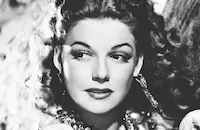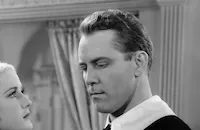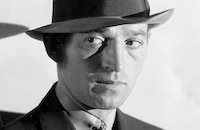Alcatraz Island

Brief Synopsis
Cast & Crew
William Mcgann
Ann Sheridan
John Litel
Mary Maguire
Gordon Oliver
Dick Purcell
Film Details
Technical Specs

Synopsis
Gat Brady, a wealthy racketeer who has escaped punishment by bribing juries and by his lawyer's clever arguments, makes an enemy of Red Carroll when he refuses to help Red's brother after he commits a paid murder. Because of the notoriety surrounding his court cases, Gat is asked to withdraw his fifteen-year-old daughter Annabel from the exclusive girl's school she attends. Though he wishes to keep his criminal past a secret from his daughter, Annabel admits that she knows about him and tells him that she loves him regardless of his reputation. In an interview with Miss Tolliver, the school matron, Gat admits that while he "helps other people spend their money," he has never killed anybody in the process. Gat wants to tour Europe with Annabel, but he is arrested on the docks for tax evasion and is sent to Leavenworth Prison. Before going to serve his sentence, Gat asks Flo Allen, Annabel's governess, to move in with Annabel and keep her away from the prison. When Flo and Annabel return from Europe, Red finds Annabel at the port and kidnaps her by telling her that her father has escaped and is hiding at his place. Eager to see her father, Annabel goes with Red, but soon discovers his lie and causes the taxi to have an accident. The police arrest Red, and he, too, is sent to Leavenworth. Gat and Red fight when Red insults Annabel, and Gat is transferred to Alcatraz Prison. Meanwhile, George Drake, the young lawyer who originally prosecuted Gat, runs into Annabel, listens to her distress over her father's mistreatment, and decides to help him. Seeking revenge on Gat, Red misbehaves at Leavenworth in order to be transferred to Alcatraz, where he plans to make sure that Gat does not get paroled. Soon after his transfer, Red is found stabbed in the prison workshop, and Gat, whose knife was used in the murder attempt, becomes the prime suspect. On his deathbed, Red names Gat as his killer, but when Drake arrives to defend him, he proves that Gat's knife was stolen from him during a diversion caused by the "China Clipper" flying overhead. Further investigations reveal that Red's killer was fellow convict The Flying Dutchman, who hanged himself after giving undercover agent David Santell a tape-recorded confession of the murder. With the help of Drake and Annabel, Gat is aquitted of the crime and sent back to Leavenworth to serve out the last six months of his sentence.

Director
William Mcgann
Cast

Ann Sheridan

John Litel
Mary Maguire

Gordon Oliver

Dick Purcell

Vladimir Sokoloff

Addison Richards
Ben Weldon

George E. Stone
Peggy Bates

Doris Lloyd
Anderson Lawlor
Charles Trowbridge
Ellen Clancy

Veda Ann Borg
Matty Fain

Edward Keane
Walter Young
Edward Stanley
Lane Chandler
Patricia Walthal
Cliff Saum
Stuart Holmes
Edward Price
Bert Ross
Johnny Harron
Sol Gorss
Milton Kibbee
Bill Gavier
Pat O'malley
Jack Gardner
Sam Bennett
William Worthington
Myrtle Steadman
Granville Owen
Dick Rich
Henry Otho
Tommy Bupp

Willard Parker
Spec O'donnell
Earl Dwire
Francis Sayles

Ralph Dunn
Galan Galt
Ted Oliver

Paul Panzer
Guy Usher
Helen Valkis

Carole Landis
Sammy Cohen
John Ogatty
Gwen Seager
Gene Hart
Connie Andre
Jack Wagner
Douglas Williams
George P. Meyers
Glen Cavender
Don Turner
Phil Ryley
Crew
Claude E. Archer
J. J. Cohn
Elmer Decker
Frank Dewar
Bryan Foy
Esdras Hartley
Michael Joyce
Charles Mack
Lou O'connell
Ralph Owen
Harvey Parry
Charles Perry
Mrs. Reiley
Irva Ross
Carroll Sax
Francis J. Scheid
William Schuck
Fred Sealock
Harry Seymour
Howard Shoup
S. K. Taylor
Homer Van Pelt
Crane Wilbur

Film Details
Technical Specs

Articles
Alcatraz Island
Although Alcatraz Island lacks the big name stars of such films as Each Dawn I Die (1939), it makes up for its lack of budget with strong characterizations and a refreshingly straightforward narrative. Gat Brady (John Litel) is a racketeer living a posh lifestyle, thanks to his crafty lawyer and a string of "paid off" juries. Gat makes an enemy of small-time hood Red Carroll (Ben Welden) when he refuses to help Red's brother escape a murder rap. Gat is also informed that his 16-year old daughter Annabel (Mary Maguire) is being kicked out of her expensive boarding school due to the bad press her father has been getting. Gat had hoped to protect Annabel from any knowledge of his business, but she is already aware of his notoriety. Gat plans a European trip with his daughter, but before he can leave he is picked up on charges that his lawyer cannot get him out of: income tax evasion. Gat is sent to Leavenworth Prison, and he leaves Annabel in the care of her governess Flo Allen (Ann Sheridan). Holding a terrible grudge against Gat, Red Carroll attempts to kidnap Annabel to exact his revenge. When that fails, he follows Gat through the prison system, hoping to kill him - or worse. After fighting in Leavenworth, Red follows Gat to the notorious maximum security prison, Alcatraz.
Alcatraz Island paints a vivid picture of the forbidding facility, both in some expansive sets (the outdoor scenes take place in a mock-up built in the San Fernando Valley), and in evocative dialogue; here fresh fish Gat talks to a long-time inmate:
Gat: I've heard about some tough cans, but I guess this joint beats 'em all.
Tony: Ain't none worse.
Gat: I wouldn't know I ain't been around much.
Tony: Wait'll you get in your bunk tonight. The fog settles down over the bay, and the siren in the lighthouse begins to moan just the same in here as bein' in your grave. Only you miss the fun of bein' dead.
Screenwriter Crane Wilbur had a long and varied career as an actor, writer, and director - both on the stage and in films. Born in 1886, he debuted as a Broadway actor in 1903 and began appearing in films in 1910. As an actor, Wilbur reached a peak as the male lead opposite Pearl White in perhaps the most famous silent serial, The Perils of Pauline (1914). Shifting to a writing career, Wilbur penned several plays for Broadway, including The Monster in 1922, which was adapted for a 1925 film with Lon Chaney. Among the dozens of films he wrote, several dealt with the penal system. In addition to Alcatraz Island, Wilbur wrote Blackwell's Island (1939), about the prison off New York's shore. Over the Wall (1938) starred Dick Foran in a story set in Sing-Sing; John Litel appeared in this film as well, this time in a good-guy role specifically, the prison chaplain! Wilbur wrote two films featuring the Dead End Kids doing time in reform school, Crime School (1938) with Humphrey Bogart and Hell's Kitchen (1939) with Ronald Reagan. Another notorious facility was highlighted in Inside the Walls of Folsom Prison (1951), which Wilbur both wrote and directed. Toward the end of his career, there was seemingly only one type of prison that Wilbur had not written about, and this topic was duly covered in Women's Prison (1955) and in House of Women (1962), his last screenplay. In his long career, Wilbur also penned screenplays for the notable Vincent Price horror vehicles House of Wax (1953), The Mad Magician (1954), and 1959's The Bat, which he also directed.
Ann Sheridan was a workhorse for Warner Bros. in the 1930s; she appeared in six other pictures in 1937 in addition to Alcatraz Island, including Black Legion, The Great O'Malley, and another prison drama, San Quentin. After dozens of such supporting roles, she came into her own with lead parts in such films as Torrid Zone and They Drive by Night (both 1940).
The producer of Alcatraz Island, Bryan Foy, was the son of vaudeville legend Eddie Foy, and as a child, part of his "Seven Little Foys" act. In the 1920s he became a writer and gagman for silent comedies at Universal, and worked with Buster Keaton on the feature film College (1927). At Warner Bros. Foy produced and directed Lights of New York (1928), the first all-talking dramatic picture. For the next thirty years Foy specialized in producing B-movies for Warner Bros. and smaller studios like Eagle-Lion, earning the nickname "The Keeper of the Bs."
Producer: Bryan Foy
Director: William McGann
Screenplay: Crane Wilbur
Cinematography: Lu O'Connell
Film Editing: Frank DeWar
Music: Heinz Roemheld
Art Direction: Esdras Hartley
Costume Design: Howard Shoup
Cast: John Litel ('Gat' Brady), Ann Sheridan (Flo Allen), Mary Maguire (Annabel 'Ann' Brady), Gordon Oliver (George Drake), Dick Purcell (David 'Harp' Santell), Ben Welden (Richard 'Red' Carroll), Addison Richards (Fred MacLane), Vladimir Sokoloff ('The Flying Dutchman').
BW-63m.
by John M. Miller

Alcatraz Island
Quotes
Trivia
Notes
Working titles for this film were Alcatraz and Grim Rock. A contemporary Hollywood Reporter news item indicates that Ben Weldon, who plays "Red" in the film, was first considered for the role played by Dick Purcell. The Warner Bros. production file for the film contains a cast sheet dated May 11, 1937, in which actor William Hopper is listed for the part played by Gordon Oliver, and Charles Foy is listed for the part played by George E. Stone, who is listed for the part played by Matty Fain. The studio's daily production schedules indicate that Hopper worked on the film, but that he was replaced by Oliver at some point during production. The Warner Bros. publicity pack for the picture indicates that filming took place at a "faithful reproduction" of Alcatraz Prison, which was built on a hill in San Fernando Valley, CA.
The file for the film in the MPAA/PCA Collection at the AMPAS Library indicates that in April 1937 the PCA urged Warner Bros. to eliminate a number of scenes, including those involving the "display of liquor" at a party, the showing of a knife stuck in a man's back, the showing of the detailed murder of a gangster and his dying agonies, and the showing of a wounded man being thrown out of an automobile. The PCA also forbade any allusion in the film to a fixed jury and suggested that the film not be shot in such a way as to "inject anything resembling the old-time gangster flavor." In response to a San Francisco Examiner newspaper article announcing Warner Bros.' plans to film a picture about Alcatraz, the PCA received a letter of protest from Attorney General Homer S. Cummings, who asked that the film not be produced because it would "give a false impression of the penal program." Discussion of the matter in a PCA inter-office memo dated August 31, 1937 brought out the fact that the article was written not by an Examiner reporter, but by a staff member of the Warner Bros. publicity department. The PCA memo also noted that because Cosmopolitan pictures was a unit headed by William Randolph Hearst, it was to be believed that the Examiner and other Hearst newspapers "put it on a little thick" in ballyhooing the film. Correspondence between the PCA and the Attorney General's office in September 1937 indicates that Warner Bros. agreed to hold up the release of the film until it was shown to the Attorney General. After viewing the film, the Attorney General's office opposed its release, claiming that it created a "romantic image of Alcatraz as the Gangster Hall of Fame," and that it portrayed prisons as using "stool pigeons" within the institutions. The film was banned by censors in Sweden, Finland and Trinidad.
According to the Warner Bros. production file, stage and screen writer Milton Herbert Gropper filed a lawsuit against the studio, claiming that Alcatraz Island was developed from a play he wrote entitled Ex-Racketeer, and that it was used as the basis of the film without his permission. Warner Bros. maintained that the film was developed from an original story by Crane Wilbur, and in January 1941, after a three-day trial, a judge ruled in favor of the studio.
A 1946 Daily Variety news item notes that Warner Bros. announced that it would film a new opening and add three new sequences to the picture in response to renewed interest in Alcatraz prison following an incident there that left five men dead and fifteen injured. The studio planned to use actual newsreel footage taken at the site of the event in the updated re-issue. No information has been located to determine if Warner Bros. went ahead with this plan.















